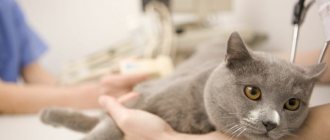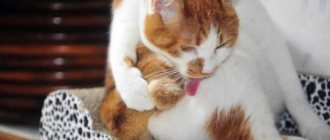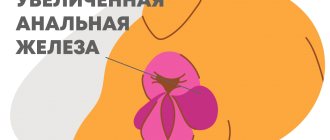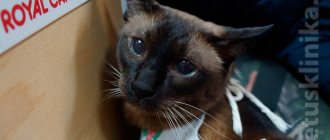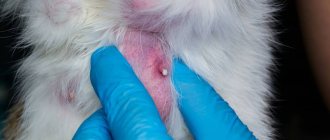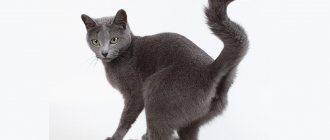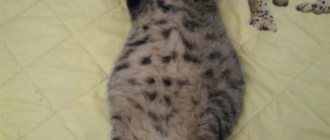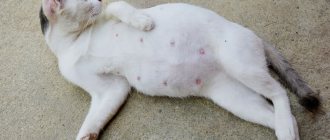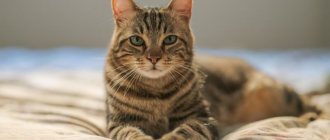The mammary glands in cats, just like in humans, serve to feed their offspring. Normally there should be four pairs of glands. Located on the cat's stomach and chest. Before birth, the functional work of the cat's mammary glands begins. (filled with colostrum).
If there is a hormonal imbalance, a false pregnancy may occur, which also leads to the functioning of the mammary glands and milk production.
Breast diseases include:
- Mastopathy.
- Mastitis.
- Tumorous, cancerous growths of the mammary glands of cats.
Prevention of all these diseases is sterilization of cats before the first heat.
Treatment is often surgical. (removal of mammary glands in cats)
Mastitis in cats
Mastitis is inflammation of the mammary glands. Occurs both during a false pregnancy and after a real pregnancy, in case of excess milk, a weak sucking reflex in kittens, death of kittens or early weaning of kittens.
Mastitis may affect one or more mammary glands. Body temperature rises. The local temperature near the inflamed gland is also high. The skin around the nipple is hyperemic. The cat is in severe pain.
There may be bleeding along with the milk.
Surgical intervention
In advanced forms of the disease, surgical intervention to remove malignant tumors cannot be avoided. Depending on the extent of the damage, one gland, a line, or all of the mammary glands may be removed.
- This complex operation is divided into two stages, separated by two weeks.
- To normalize the cat’s life, doctors recommend surgery to remove the ovaries.
- The purpose of such surgical intervention in the animal’s body is to reduce the number of estrogens, which contribute to the development of mastopathy.
It is better to listen to the advice of a veterinarian, because mastopathy is a precancerous condition and can lead to the death of your beloved pet. The animal must undergo initial rehabilitation in a clinic.
Mastopathy in cats
Mastopathy in cats is an enlargement of the mammary glands. Sometimes it's normal. But more often the process is still pathological.
Mastopathy in cats is considered normal when feeding kittens and does not require treatment.
Pathological mastopathy occurs when a cat’s hormonal levels are disrupted.
It appears as small lumps on the cat's mammary glands. Mastopathy caused by hormonal imbalance will inevitably develop into cancer, so treatment must be timely.
Causes that lead to breast problems.
Hormonal changes are the main cause of mastopathy. Characteristic of both real and false pregnancy, which can be provoked by a sterile cat. Ovulation has occurred during fertilization, however, sperm that are not able to fertilize eggs contribute to false pregnancy, lactation and, as a result, mastitis and, as a result, mastopathy. The size of the mammary gland increases significantly, and it looks unnatural.
Premature lactation is another possible cause of tumor, when there is already a lot of milk, but there are still no kittens. After some time, the milk begins to stagnate and turn into flakes, and then the glands become inflamed.
Stress during pregnancy in cats is an exacerbation of all sorts of ailments in them. Against this background, several unpleasant phenomena can occur at once, including the development of inflammation in cats that have not given birth before.
Note! If your cat's belly has not yet begun to grow, and her mammary glands have become larger, it is worth checking her hormonal levels.
Mammary tumor in a cat
Tumor of the mammary gland in a cat - Lumps of the mammary glands. It is more common in cats after 6 years of age. Breast tumors are often malignant. Even if the tumor is benign, it will eventually develop into a malignant tumor.
A malignant tumor grows throughout the body. The entire body is poisoned and healthy cells die.
Owners usually notice a tumor of the mammary glands when the tumor has already opened, and this is accompanied by the spread of metastases.
For prevention, conduct an independent examination of your cat’s mammary glands; if there is the slightest lump, immediately book your pet with a veterinarian.
Diagnostics
At the first stage of the disease, there may be no main externally noticeable symptoms (redness, foreign impurities in milk, refusal to feed kittens). However, if you notice unusual lethargy and decreased appetite in a nursing cat, this is a reason to definitely show your pet to a doctor. To diagnose mastitis, it is necessary to conduct an in-person examination and, if necessary, take a general blood test. The sooner mastitis is detected in a cat and treatment is prescribed, the fewer complications there will be and the faster the recovery period will pass.
Taking a biopsy
The process of taking material is not painful for the animal and looks like an injection with a regular syringe. Tumor cells caught in the needle are sent for examination. Having received the results of the study, we can say whether this neoplasm is benign or malignant, and what type it is.
Taking a biopsy does not affect the growth rate of the tumor in any way. Unfortunately, the most common type of tumor in cats is adenocarcinoma. This malignant tumor is prone to relapse (repeated growth after removal) and metastasis (the appearance of foci of tumor growth in organs and tissues distant from the primary sites of detection).
What is mastopathy
Mastopathy is an insidious disease that is often confused with mastitis, which develops in animals that feed newborn offspring with breast milk. Many owners believe that if their cat is not a nursing mother, then she is not at risk for mammary gland diseases.
Cats have 4 pairs of mammary glands, the main function of which is to produce and secrete breast milk. Cats also have mammary glands that are in an undeveloped state.
Mastopathy is a disease of the mammary glands, characterized by the growth of atypical tissue in it. The pathology is accompanied by severe pain, thirst and progressive exhaustion. The disease is manifested by general engorgement of the mammary glands, the appearance of small or large nodules, swellings, and bumps.
With the benign nature of the disease, small nodes are enclosed in a connective tissue capsule, due to which atypical cells are prevented from merging with nearby healthy tissues. As the tumor grows, compression of the breast tissue, blood vessels and nerves occurs against a background of severe pain. At this stage, the pathology is successfully treated surgically, and the cat continues to live carefree.
When a benign tumor degenerates into a malignant one, atypical cells grow into healthy tissues and metastasize to lymph nodes and distant organs. It is no longer possible to cure animals with cancerous tumors; life can be extended as much as possible with the help of courses of chemotherapy, hormonal and painkillers. Although sometimes in such a situation it is more humane to euthanize an exhausted pet.
Treatment at home
An owner who wants to save and cure an animal should not engage in self-treatment at home or trust the life of the pet to unqualified specialists. Traditional methods in the form of applying cabbage leaves, rubbing with camphor oil or dressings with ichthyol ointment or Vishnevsky's liniment do not have a therapeutic effect in case of tumor pathology, and in the case of oncological nature of mastopathy, they can accelerate the growth of the tumor.
If the benign nature of the disease is confirmed and there are no large nodes, a veterinary specialist may prescribe a course of novocaine blockade of the diseased gland. To relieve pain in the affected mammary glands at home, you can apply cold compresses or perform a gentle massage on the affected area.
Along with pain relief, homeopathic medicines are often used: Mastomethrin, Hormel and Coenzyme compositum. The duration of the course is prescribed by a veterinary specialist and depends on the stage of the pathology.
Diagnosis of mastopathy
Necessary examination methods that a woman should receive when visiting a mammologist:
- examination and manual examination of the mammary glands, examination of the axillary, subclavian, cervical lymph nodes;
- Ultrasound of the mammary glands and lymph nodes;
- x-ray mammography (all women over 40 years of age);
- blood tests (general analysis, biochemical study, hormonal status, tumor markers);
- when cysts are detected, puncture them with cytological examination of the contents;
- when a nodular formation is detected, cells are collected from the formation using a needle and syringe for cytological examination.
Conclusion
To avoid the onset of the disease, you need to undergo a full examination of the animal on time, tests and visual examinations provided by veterinary clinics. By contacting our veterinary office, you will receive qualified assistance from specialists on any problem your pet may have.
You can also call a doctor at home, our veterinarians will arrive on time, at any time convenient for you. You should not engage in amateur treatment, this can lead to exacerbation or worsening of a disease that is at an early stage of development. Also, unjustified self-medication of an animal can worsen other parts of the body.
Breast cancer involves not only death, but also a deterioration in the life of the animal and its owner. It is a pity that not every person, being the owner of their pets, is fully aware of the responsibility of caring for a sick animal. Some people, unwilling to undergo treatment, throw their cat out into the streets or euthanize them, not wanting to endure the difficulties that arise. Let us be patient with our pets, who bring warmth and comfort to our homes.
At-risk groups
Mastopathy most often affects mature and elderly cats or cats with hormonal problems. The risk groups for tumor diseases of the mammary glands include the following categories of animals:
- cats in a state of pregnancy or heat;
- animals after premature loss of cubs, stillbirth or death of offspring;
- males and females taking hormonal contraceptives for a long time;
- Siamese cats, in which the disease is registered 2 times more often than in other breeds.
Surgery
Once the diagnosis is confirmed, the remaining ovarian tissue must be removed. Cats with ovarian remnants may have an increased risk of developing milk-pack tumors and ovarian neoplasia (not proven). In addition, most owners are not very tolerant of clinical signs of estrus and behavioral changes in operated cats. To remove the remnant parts of the ovary, we perform a laparotomy. We look through the entire abdominal cavity, starting with the most likely places of localization of remnants - the tip of the ovary. The next most likely places to find remnants are the omentum and peritoneum. Reminents can be one-sided or two-sided.
In rare cases, the disease may go away on its own, but in most cases, treatment for FAM takes weeks or even months.
Treatment of mastopathy
The treatment regimen for mastopathy should be selected individually for each woman. When prescribing a regimen, the reasons for the development of mastopathy, examination data, and changes in blood tests should be taken into account. If necessary, a woman should consult such specialists as a neurologist, gynecologist, endocrinologist, or therapist. Also, according to the doctor’s decision, if a nodular formation is identified, surgical treatment can be performed in the oncology department with histological examination of the removed area of the mammary gland.
In her life, almost every woman has at least once felt pain, discomfort in the mammary glands, or independently discovered a lump in the mammary gland. In such a situation, each woman behaves differently. One goes to a mammologist or oncologist, explains the sensations that are troubling her, undergoes an examination and, in the future, either receives a course of treatment or simply receives recommendations on self-examination and the frequency of visits to the mammologist. The other suffers pain, is tormented by doubts, and every time she hears from friends or acquaintances about a cancerous tumor, she thinks, “after all, not everything is all right with me either,” but due to her own fear of hearing a terrible diagnosis or simply from the eternal “not up to herself” continues to put off visiting the doctor.
You can find out more about the work of the hospital by calling +7 (495) 292-39-72.
Preparation for surgical treatment of gynecomastia in men
No complex preparatory activities are carried out. The patient undergoes a comprehensive examination, which allows him to assess his health condition and choose the appropriate tactics for surgical intervention. Based on the diagnostic data, the doctor makes predictions for the future and selects the correct treatment regimen that prevents the development of complications, both during surgery and in the postoperative period.
The operation is performed on an empty stomach. The doctor will tell you in detail about the features of the surgical stage and recovery period. You must strictly follow your doctor’s prescriptions; if you have any questions or feel unwell, it is recommended that you contact your doctor without delay.
Possible complications and their consequences
With early diagnosis and timely contact of the cat owner to the clinic, mastopathy can be successfully treated using a conservative or surgical method. Benign neoplasms are enclosed in a fibrous capsule, so there is a chance to remove the node without long-term consequences.
Most often, pet owners notice changes in the mammary glands in advanced stages. Possible complications of mastopathy are incurable cancerous tumors that grow into nearby tissues and metastasize to internal organs. Ulceration of the skin in pathology is fraught with the addition of a secondary infection and the development of purulent forms of mastitis and mastopathy, which can cause blood poisoning and death of the animal.
Traditional methods of treatment
Easy to use, they help (not instead!) of medication and physiotherapy:
- in the initial stage: milk is expressed and the glands are bandaged, fed with dry food and given a little drink after meals to reduce milk production; by the way, drinking 2 tablespoons of sage infusion will help with this. l. 3 times a day; For now, kittens are fed artificial formula, mother’s milk is not allowed;
- to relieve swelling, beat off a cabbage leaf and apply it to the sore spot, fix it with gauze;
- relieve inflammation: infusion of sage, chamomile flowers and marigolds or oak bark: 4 g. raw materials are poured with 150 ml of boiling water, left in a thermos for 3-4 hours; at 36 deg. filter and make compresses on the milk lobes 2 times a day;
- flax seed: ⅓ tsp. l. seeds + 10 gr. pour water into the animal’s neck; the procedure is daily for 1 month, and improvement occurs after 2 weeks;
- Elderberry juice: give ¼ table on an empty stomach. l. berry puree rich in vitamins and bioactive components that strengthen the immune system and reduce inflammation; recommended for prevention during the postpartum period;
- apricot kernels: serve as dietary supplements, for 1 dose: 2 pcs. finely chopped; amygdalin from seeds helps with cancer;
- compress from medicinal ointment: alcohol tincture of propolis + lanolin + medicinal petroleum jelly, take 1:5:5; apply for 4-5 hours.
Apply until visible improvements. Do not warm up without consulting a doctor!
Symptoms of mastopathy
For mastopathy, the most typical complaints are:
- breast tenderness,
- a feeling of increasing their volume,
- engorgement and swelling of the glands,
- the presence of clear or colostrum-like fluid discharge from the nipples of the mammary glands.
Pain may radiate to the armpits, shoulder and shoulder blade. The most common is a combination of symptoms of mastopathy and premenstrual syndrome. The main complaints in these conditions are: headache (often migraine-type), swelling of the face and limbs, nausea, less often vomiting, impaired bowel function, flatulence. With the neuropsychic form of premenstrual syndrome, complaints such as irritability, depression, weakness, tearfulness and aggressiveness may be associated. Difficulties in determining the cause of pain are due to the fact that pain can occur not only with pathology of the mammary gland, but also with cervicothoracic osteochondrosis, radiculoneuritis, intercostal neuralgia and is eliminated with appropriate therapy.
